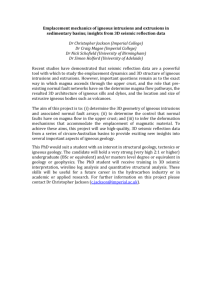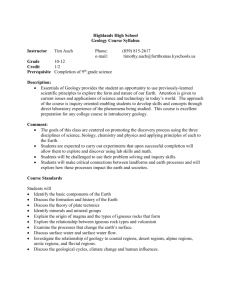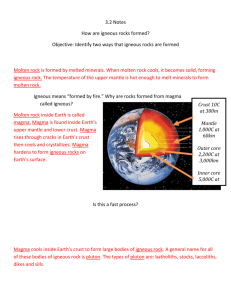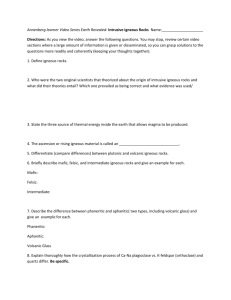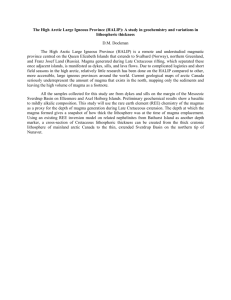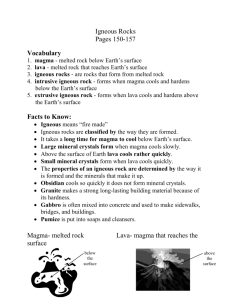Igneous Geology - Earth Science Teachers` Association
advertisement
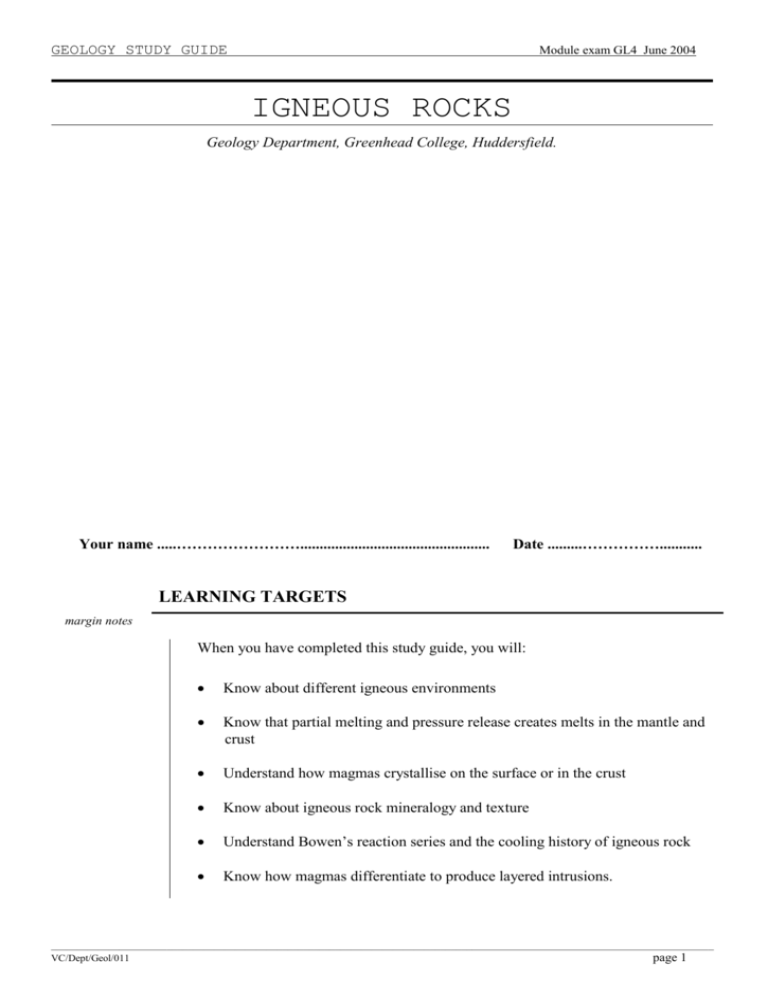
GEOLOGY STUDY GUIDE Module exam GL4 June 2004 IGNEOUS ROCKS Geology Department, Greenhead College, Huddersfield. Your name .....……………………................................................. Date .........……………........... LEARNING TARGETS margin notes When you have completed this study guide, you will: Know about different igneous environments Know that partial melting and pressure release creates melts in the mantle and crust Understand how magmas crystallise on the surface or in the crust Know about igneous rock mineralogy and texture Understand Bowen’s reaction series and the cooling history of igneous rock Know how magmas differentiate to produce layered intrusions. ______________________________________________________________________________________________________________________________ VC/Dept/Geol/011 page 1 GEOLOGY STUDY GUIDE Module exam GL4 June 2004 Resources Here is a choice of resources to use. You do not need to look at them all but clearly the more you read the better your knowledge of case studies will be. Tick the box once you have used the resource. If you read a photocopied extract then highlight it to help you reread it for revision. If you make notes from a video tape make sure that the notes are headed with the name of the tape so that you know the source of your information. Case studies are very useful for essay questions so you should keep a separate list of the examples that you have researched. IR1 IR2 IR3 IR4 IR5 IR6 IR7 IR8 IR9 IR10 IR11 IR12 IR13 IR14 IR15 IR16 IR17 IR 18 IR 19 IR 20 IR 21 IR 22 Understanding Geology David Webster p 139-145 Geoscience Edwards and King p. 59-68 Geological Science by Andrew McLeish p. 177-180 Video Horizon. The Day the Earth Melted. Tapes 9 and 14 50 mins Library Video Horizon The Day the Earth Melted Video Volcanic Iceland Tape 13 22mins Video Christmas Lectures 1995 Tape 12 19mins Library Video Christmas Lectures 1995 Diagrams of examples of igneous rock emplacement and intrusion Library Video Natural World: Islands of the Fire Goddess - Hawaii Earth Story Programme Ring of Fire Tape 35 and 39 50mins Library Video Earth Story Programme Ring of Fire Earth Story Programme The Deep Tape 35 and 39 50mins Library Video Earth Story Programme The Deep Earth Story Programme Journey to the Centre of the Earth Tape 35 and 39 50mins Library Video Earth Story Programme Journey to the Centre of the Earth Phase diagram exercise Texture matrix Video Inside Volcanoes Tapes 1, 3, 4 22 mins Library Pitcher, W.S. The Nature and Origin of Granites Library OU Earth Materials Powerpoint Palisades Sill, and Skye, the Cuillins and the Red Hills Solid Solution crystal lattice and phase diagrams Library Kennett, P and Ross, C.A. Aspects of Geology Igneous rocks Library Press and Siever Earth Library Hatch, Wells and Wells Petrology of the Igneous Rocks Powerpoint to show igneous rock textures Websites www.geolab.unc.edu/Petunia/VG/Mount_Airy/main.html www.bris.ac.uk/Depts/Geol/vft/oman.html volcano.und.nodak.edu/vwdocs/vwlessons/atg.html www.soton.ac.uk/~imw/igneous.htm uts.cc.utexas.edu/~rmr/ www.abdn.ac.uk/geology/profiles/auming/arran/arran.htm There are many other websites you could search. ______________________________________________________________________________________________________________________________ VC/Dept/Geol/011 page 2 GEOLOGY STUDY GUIDE margin notes Module exam GL4 June 2004 TASK 1 PLATE MARGINS Read through your AS notes on the five different types of plate margins. For each you should know diagram to show processes and features types of igneous and volcanic rocks type of metamorphism depth of earthquake foci faulting and folding (if relevant) You will be tested on this part of the specification so it is essential to understand it before you continue to the A2 course. TASK 2 THE DAY THE EARTH MELTED Watch IR 4 Make notes on the BIG IDEAS that have developed from Dan MacKenzie’s research into the physics of the mantle. Here are some questions to be answered: Why is there so much molten rock produced in the mantle? What is the nature of the mantle? How does the mantle flow? How does magma move through solid rock? What are mantle plumes? What is the significance of the Deccan Traps in India for the understanding of mantle plumes? What is pressure release and why is it so important? Why is oceanic crust a constant thickness of 6/7kms? How does Dan MacKenzie explain the geology of the oceanic crust which makes up Iceland? TASK 3 IGNEOUS ENVIRONMENTS Each igneous environment produces magma of different compositions. Read the relevant pages in IR1, IR2 and IR3, concentrating on the types of magmas produced at each plate margin and the processes which occur there. There are several videos (IR 5, IR 6, IR 8, IR 9, IR 10, IR 11) which will give you a visual image of plate margins and will add case studies such as Hawaii, the Pacific Ring of Fire, Iceland, the Andes and the Rockies. Make time to watch at least one of them at home. In lesson time we will summarise your findings by going through each plate margin in turn, using diagrams to explain how magmas are produced. Use this box for notes ______________________________________________________________________________________________________________________________ VC/Dept/Geol/011 page 3 GEOLOGY STUDY GUIDE margin notes Module exam GL4 June 2004 TASK 4 PHASE DIAGRAMS Complete the exercise IR 12 which is based on the diagrams from IR 2 p 57-59 TASK 5 EMPLACEMENT AND EXTUSION 1. Define emplacement, intrusion and extrusion. 2. Draw a diagram to show each process and explain the difference between them by labelling your diagram. 3. Brainstorm on the factors which you think could cause magma to rise through the crust. 4. Discuss the importance of each factor and make class notes. TASK 6 EMPLACEMENT OF PLUTONS, DYKES AND SILLS Using the diagrams (IR 7) of examples of the Arran granite, the Beinn an Dubhaich granite in Skye and the Midland Valley sill as well as your observations in Arran, make notes on the emplacement of igneous intrusions. Be aware of the difference between diapiric emplacement and stoped emplacement of plutons. TASK 7 IGNEOUS COMPOSITION IR 3 p.53 shows the composition of igneous rocks. You need to know their mineralogy in more detail than at AS. Redraw the table to include only the rocks you need to know, which are: granite, microgranite, rhyolite, diorite, andesite, gabbro, dolerite, basalt and peridotite. Add % mineral composition of each rock. IR 2 p.56 has an interesting block diagram which shows the same information. Which diagram will you prefer to learn? TASK 8 IGNEOUS PRACTICAL Use the practical sheets to draw and label specimens of the nine rocks in Task 7. At A-level it is important to identify the mineralogy and texture of each rock. You need to use lenses to look carefully at grain size and composition. TASK 9 XENOLITHS Write a report on igneous xenoliths. It will probably be about 2 sides and include diagrams and sketches. Your report should include the following: 1. 2. 3. 4. Description of several examples of xenoliths, using slides, samples and maps An explanation of how they form, using the Law of Included Fragments to explain the relative age of a xenolith and its igneous rock Comment on how xenoliths change magma composition using the words assimilation, contamination and digested Comment on how xenolith orientation varies in diapiric and stoped plutonic intrusions continued..….. Use this bo x for notes ______________________________________________________________________________________________________________________________ VC/Dept/Geol/011 page 4 GEOLOGY STUDY GUIDE Module exam GL4 June 2004 margin notes You have these resources available to you: A slide of a xenolith in micro-granite Slides of Shap Granite Quarry A specimen of a xenolith Building Stones Guide to Huddersfield Shop-fronts in Huddersfield (especially the Nawaab restaurant) You could also do some research using books and CD Roms in the library. Examples of Beinn an Dubhaich granite and Arran granite in Scotland Deadline……………………………………….. TASK 10 IGNEOUS TEXTURES Use IR 13 to describe igneous textures. Explain how each texture is interpreted. Draw labelled diagrams to illustrate the texture of selected thin sections of igneous rocks magnified x 10 through a microscope. TASK 11 BOWEN’S REACTION SERIES Bowen carried out experiments using magma melts in a laboratory to find out the order of crystallisation of minerals as a magma cooled. He found that a clear sequence was followed in theory. This is shown in IR 2 p.57 in Figure 4.5. We will draw a simplified version of this diagram in class and explain the difference between the discontinuous reaction series and the continuous reaction series. TASK 12 EXAMPLES OF BOWEN’S REACTION SERIES In real magmas minerals form in the order of Bowen’s reaction series but the actual minerals that develop depend on the original composition of the magma. This is called the cooling history of an igneous rock. Choose a specimen of gabbro, Shap granite and quartz feldspar porphyry. For each give a description of its cooling history, after examining the mineralogy and texture carefully under a lens or a microscope. TASK 13 MAGMATIC DIFFERENTIATION Gravity settling and fractional crystallisation can produce layered differentiated igneous intrusions. Read IR 2 p 57 and IR 3 p 59. Carry out this experiment carefully in the classroom. Fill a jam jar with golden syrup to simulate a magma chamber full of melt. We can use a variety of materials to simulate crystals of different sizes and densities forming in the magma chamber. Drop a paper clip and a drawing pin into the magma chamber. Which reaches the bottom of the magma chamber first? Why? Now repeat the experiment with a grain of rice and a piece of pasta. Observe which item reaches the bottom first. Record your results. Write out two bivariate hypotheses linking size and density of crystals with settling rate. Now clean up. The crystals in these differentiated intrusions are often called cumulates because the denser and larger crystals accumulate at the base of the magma chamber. ______________________________________________________________________________________________________________________________ VC/Dept/Geol/011 page 5 GEOLOGY STUDY GUIDE margin notes Module exam GL4 June 2004 TASK 14 PALISADES SILL Watch IR 17, is a powerpoint of differentiated igneous intrusions which will help you understand the process of magmatic differentiation. On a plain sheet of paper draw a large diagram showing the cross-section of the Palisades Sill, New York, from IR 2 p 57 or IR 3 p 60. Using clear labels explain the differentiation processes which cause layering of minerals within the sill. You will need to add a scale. The presence of chilled margins is critical to the understanding of the minerals and their position in the sill. TASK 15 SOLID SOLUTION SERIES Some minerals have crystal lattices which have spaces the right size for ions to move into. This changes the chemistry of the mineral. According to the availability of ions in the magma(or melt) and the temperature of the magma it is possible to have a gradation of chemical composition in one mineral. This process is called solid solution. The two common minerals in which solid solution can occur are olivine and plagioclase feldspar. These have continuous reaction series because the exchange of ions can continue throughout the cooling of the melt until the magma crystallises completely. We have met the continuous reaction series of plagioclase feldspar as part of Bowen’s reaction series. Use IR 18 to explain the process of solid solution. TASK 16 OLIVINE AND PLAGIOCLASE Olivine can have an iron-rich (fayalite)or a magnesium-rich composition (forsterite), while plagioclase can have a sodium-rich (sodic) (albite)or calciumrich (calcic) (anorthite) composition. 1. In class we will talk through olivine and plagioclase phase diagrams using the terms liquidus and solidus to show how the composition of melts and crystals can change as temperature falls. 2. Explain the formation of zoned crystals and corona structures in crystals in the light of the solid solution process. TASK 17 BGS MAPS Look at appropriate BGS maps and slides to see how igneous and volcanic features are shown. TASK 18 EXAM QUESTION PACK Complete the Igneous Rocks EQP Deadline…………………………………… Use this box for notes ESTA GEOTREX The Geology Teachers Resource Exchange Contributor: Alison Quarterman Establishment: Greenhead College Date:May 05 ______________________________________________________________________________________________________________________________ VC/Dept/Geol/011 page 6 GEOLOGY STUDY GUIDE Module exam GL4 June 2004 ______________________________________________________________________________________________________________________________ VC/Dept/Geol/011 page 7
